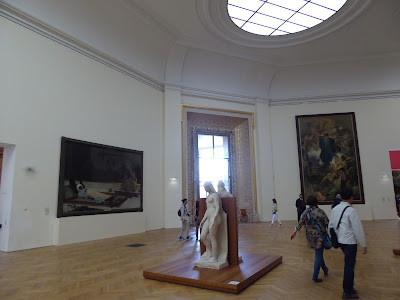For years, I've wanted to cast my eyes on the famous bust by Jean-Baptiste Carpeaux, Pourquoi Naître Esclave, at the Petit Palais. I can't count the number of times I've walked by the museum and never set foot inside.
Last week, Tom and I finally paid a visit to the "Little Palace." The building is incredibly well endowed with natural light. On either side of the large glass panel that looks over the semi-circular garden opposite the entrance is a marble bust of an African man.
The artist's name is not indicated on the information cards accompanying these works. The only date mentioned is "19th-century" - with a question mark.
We went straight downstairs and to the rear of the museum to Room 14, which is devoted to sculptures by Carpeaux. And there she was...
Pourquoi naître esclave?
Jean-Baptiste Carpeaux
1868 Patinated Plaster
© Discover Paris!
I stood in front of the sculpture and gazed into the hollow pupils of its patinated plaster eyes.
Pourquoi naître esclave? - detail
Jean-Baptiste Carpeaux
1868 Patinated Plaster
© Discover Paris!
This bust is one of eight that Carpeaux created in preparation for the incarnation of the African persona found in the sculpture Les Quatre Parties du Monde. It and the bust at the Musée des beaux-arts de Reims are the only two made of plaster. Other busts are made from terra cotta, bronze, or marble.
After satisfying this long-held desire, Tom and I took a (relatively) quick stroll through the rest of the museum to see the permanent collection and to decide where we'd concentrate our time upon subsequent visits.
As expected, we found a few paintings that depict blacks. The most impressive one was an oversized painting by Jean-Joseph Benjamin-Constant called Le Jour des funérailles, scène du Maroc.
.
Le Jour des funérailles, scène du Maroc (La Mort de l'émir)
Jean-Joseph Benjamin-Constant
1889 Oil on canvas
© Discover Paris!
It is located on the ground floor in Room 3, which is part of a long gallery that houses 19th-century paintings.
19th-century paintings
© Discover Paris!
I found the detail and the coloring in this work to be magnificent!
Le Jour des funérailles, scène du Maroc (La Mort de l'émir) - detail
Jean-Joseph Benjamin-Constant
1889 Oil on canvas
© Discover Paris!
The Petit Palais's Web site gives a detailed description of this painting as well as information about its author (in French).
The museum is small enough to easily see the entire collection in a single day. Because it belongs to the city of Paris, entry to the permanent collections is free.
Petit Palais
Avenue Winston Churchill
75008 Paris
Metro: Champs-Elysées Clémenceau (Lines 1 and 13)
Open Tuesday through Sunday from 10 AM to 6 PM
************
If you like this posting, share it with your friends by using one of the social media links below!
Last week, Tom and I finally paid a visit to the "Little Palace." The building is incredibly well endowed with natural light. On either side of the large glass panel that looks over the semi-circular garden opposite the entrance is a marble bust of an African man.
The artist's name is not indicated on the information cards accompanying these works. The only date mentioned is "19th-century" - with a question mark.
We went straight downstairs and to the rear of the museum to Room 14, which is devoted to sculptures by Carpeaux. And there she was...
Jean-Baptiste Carpeaux
1868 Patinated Plaster
© Discover Paris!
I stood in front of the sculpture and gazed into the hollow pupils of its patinated plaster eyes.
Jean-Baptiste Carpeaux
1868 Patinated Plaster
© Discover Paris!
This bust is one of eight that Carpeaux created in preparation for the incarnation of the African persona found in the sculpture Les Quatre Parties du Monde. It and the bust at the Musée des beaux-arts de Reims are the only two made of plaster. Other busts are made from terra cotta, bronze, or marble.
After satisfying this long-held desire, Tom and I took a (relatively) quick stroll through the rest of the museum to see the permanent collection and to decide where we'd concentrate our time upon subsequent visits.
As expected, we found a few paintings that depict blacks. The most impressive one was an oversized painting by Jean-Joseph Benjamin-Constant called Le Jour des funérailles, scène du Maroc.
.
Jean-Joseph Benjamin-Constant
1889 Oil on canvas
© Discover Paris!
It is located on the ground floor in Room 3, which is part of a long gallery that houses 19th-century paintings.
© Discover Paris!
I found the detail and the coloring in this work to be magnificent!
Jean-Joseph Benjamin-Constant
1889 Oil on canvas
© Discover Paris!
The Petit Palais's Web site gives a detailed description of this painting as well as information about its author (in French).
The museum is small enough to easily see the entire collection in a single day. Because it belongs to the city of Paris, entry to the permanent collections is free.
Petit Palais
Avenue Winston Churchill
75008 Paris
Metro: Champs-Elysées Clémenceau (Lines 1 and 13)
Open Tuesday through Sunday from 10 AM to 6 PM
Entrée to Black Paris!™ is a Discover Paris! blog.
If you like this posting, share it with your friends by using one of the social media links below!








2 comments:
I love the Petit Palais--so glad you two finally got in there! The café is pleasant for coffee or tea, but I've always had terrible lunches there, so don't go in hungry! They have some Art Nouveau treasures which I love; and on on my "Ben Franklin's Paris" tour, I point out the bust and portrait of him made from life while he was in Paris.
We're looking forward to going back to the museum, Anna. LOL about the café!
Post a Comment